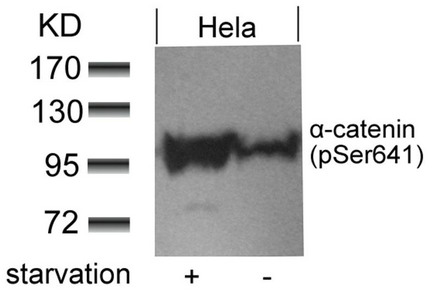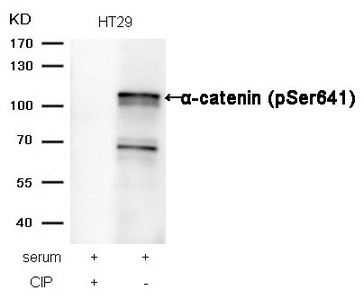Phospho-CTNNA1 (Ser641) Antibody
-
中文名称:磷酸化-CTNNA1 (Ser641)兔多克隆抗体
-
货号:CSB-PA596605
-
规格:¥2454
-
图片:
-
其他:
产品详情
-
产品名称:Rabbit anti-Homo sapiens (Human) CTNNA1 Polyclonal antibody
-
Uniprot No.:P35221
-
基因名:
-
宿主:Rabbit
-
反应种属:Human,Mouse
-
免疫原:Peptide sequence around phosphorylation site of serine 641 (D-D-S(p)-D-F) derived from Human a-catenin.
-
免疫原种属:Homo sapiens (Human)
-
克隆类型:Polyclonal
-
纯化方式:Antibodies were produced by immunizing rabbits with synthetic phosphopeptide and KLH conjugates. Antibodies were purified by affinity-chromatography using epitope-specific phosphopeptide. Non-phospho specific antibodies were removed by chromatogramphy usi
-
浓度:It differs from different batches. Please contact us to confirm it.
-
产品提供形式:Liquid
-
应用范围:ELISA,WB
-
推荐稀释比:
Application Recommended Dilution WB 1:500-1:1000 -
Protocols:
-
储存条件:Upon receipt, store at -20°C or -80°C. Avoid repeated freeze.
-
货期:Basically, we can dispatch the products out in 1-3 working days after receiving your orders. Delivery time maybe differs from different purchasing way or location, please kindly consult your local distributors for specific delivery time.
相关产品
靶点详情
-
功能:Associates with the cytoplasmic domain of a variety of cadherins. The association of catenins to cadherins produces a complex which is linked to the actin filament network, and which seems to be of primary importance for cadherins cell-adhesion properties. Can associate with both E- and N-cadherins. Originally believed to be a stable component of E-cadherin/catenin adhesion complexes and to mediate the linkage of cadherins to the actin cytoskeleton at adherens junctions. In contrast, cortical actin was found to be much more dynamic than E-cadherin/catenin complexes and CTNNA1 was shown not to bind to F-actin when assembled in the complex suggesting a different linkage between actin and adherens junctions components. The homodimeric form may regulate actin filament assembly and inhibit actin branching by competing with the Arp2/3 complex for binding to actin filaments. Involved in the regulation of WWTR1/TAZ, YAP1 and TGFB1-dependent SMAD2 and SMAD3 nuclear accumulation. May play a crucial role in cell differentiation.
-
基因功能参考文献:
- These findings provide mechanistic insight into the WNT-mediated regulation of the DNA damage response and suggest a novel role for the alpha-catenin-beta-catenin complex in the nucleus. PMID: 28348105
- pseudogene CTNNAP1 is a potential tumor suppressor participating in CRC pathogenesis by competing with the parent gene CTNNA1 for microRNA-141. PMID: 27487124
- Hypermethylation of the CTNNA1 promoter was associated with unfavorable karyotype, and possessed the higher frequency of coexisting with ASXL1 and RUNX1 mutations. PMID: 27129146
- The results of this study demonstrate that causative variants identified in the CTNNA1 and CYP4V2 genes are also associated with Leber Congenital Amaurosis. PMID: 28453600
- alpha- and beta-catenins may be important in the early stages of phyllodes tumours development, while E-cadherin may be required for malignant development PMID: 22571452
- This work identified alpha-catenin as another molecule in addition to E- and P-cadherin that were targeted to inactivate homotypic cell-in-cell structures formation in human tumor cells. PMID: 26192076
- Progressive loss of e-cadherin/alpha-catenin expression is associated with an aggressive phenotype (low differentiation, increased metastatic activity/advanced stage) in thyroid carcinomas. PMID: 27273957
- study identifies CTNNA1 gene variants as a cause of macular dystrophy, indicates that CTNNA1 is involved in maintaining RPE integrity PMID: 26691986
- The results demonstrate a Fas-mediated apoptotic signaling pathway that is enhanced by the age-dependent loss of alpha(E)-catenin in renal tubule epithelial cells. PMID: 25894537
- Actin-dependent CTNNA1 clustering is a unique molecular mechanism mediating both integrity and reassembly of the cell-cell adhesive interface formed through weak cis- and trans-intercadherin interactions. PMID: 26261181
- alpha-catenin is a reversible, stretch-activatable sensor that mechanically links cadherin complexes and actin and is an indispensable player in cadherin-specific mechanotransduction at intercellular junctions. PMID: 25544608
- alpha-catenin functions as a tumor suppressor in E-cadherin-negative basal like breast cancer cells by inhibiting NF-kappaB signaling. PMID: 25483184
- CTNNA1 hypermethylation was detected in three out of four with isolated del(5q), one with trisomy 11, one with monosomy 7, one out of four with del(20q), and one out of seven with complex abnormalities, but in none with trisomy 8. PMID: 25153418
- CTNNA1 methylation is a recurrent event but has no influence on prognosis in acute myeloid leukemia PMID: 24685333
- CTNNA1 expression is specifically downregulated in basal-like breast cancer subtype, correlates with clinical outcome and inversely correlates with TNF and RELB expression. PMID: 24509793
- A germline truncating allele of alpha-E-catenin (CTNNA1) was identified that was present in two family members with invasive diffuse gastric cancer and four in which intramucosal signet ring cells were detected as part of endoscopic surveillance. PMID: 23208944
- A discrete trimeric complex of beta-catenin, alpha-catenin and the tumor suppressor APC, forms in the cytoplasm in response to Wnt signaling. PMID: 22469663
- Data show that E-cadherin and alpha-catenin were predominantly expressed in the cell membranes, whereas beta- and gamma-catenin were found both in the cell membrane and cytoplasm. PMID: 20933443
- The expressions of E-cd and alpha-cat are significantly lower in prostate cancer than in benign prostatic hyperplasia, and they are not associated with cancerous metastasis, but negatively correlated with the PSA level in PCa patients. PMID: 22774602
- study presents evidence that in the cadherin-catenin complex alpha-catenin contributes to the binding strength of another catenin, p120, to the same complex; data suggest alpha-catenin-p120 contact within the cadherin-catenin complex can regulate cadherin trafficking PMID: 21937720
- binding studies suggest that vinculin must be in an activated state to bind to alpha-catenin and that this interaction is stabilized by the formation of a ternary alpha-catenin-vinculin-F-actin complex, which can be formed via the F-actin binding domain PMID: 22493458
- Report loss of CTNNA1 as lobular carcinoma in situ of the breast progresses to more invasive lesions. PMID: 22080244
- Data demonstrate that the expression of alpha-E-catenin is increased by Sec6 siRNAs, and E-cadherin and beta-catenin localize mainly at the cell-cell contact region in HSC3 cells, which were transfected with Sec6 siRNA. PMID: 22381337
- The expression of alpha-catenin was significantly lower in the invasive group than in the non-invasive group of pituitary adenoma. PMID: 16927799
- These results suggest that JNK affects the association of alpha-catenin with the adherens junction complex and regulates adherens junctions. PMID: 21030692
- 4 biallelic inactivating alpha-catenin mutations were found among 55 human breast cancer cell lines. All caused premature termination. Loss of alpha-catenin protein expression was associated with the lobular subtype in primary breast cancers. PMID: 19763817
- The E-cadherin-catenin complex is the factor indicative of metastasis and disease progression in gastric cancer. PMID: 20529814
- The study objective was to assess changes in the expressions of E-cadherin and alpha-, beta- and gamma-catenin proteins in pancreatic duct carcinoma in correlation with clinicopathological parameters, lymph node involvement and distant metastases. PMID: 20529828
- Data show that actin bundle formation and subsequent linkage between actin bundles and VE-cadherin through alpha- and beta-catenins are important for the stabilization of VE-cadherin at the cell-cell contacts in cAMP-Epac-Rap1 signal-activated cells. PMID: 20032304
- An evolutionarily conserved PTEN-C/EBPalpha-CTNNA1 axis controls myeloid development and transformation. PMID: 20371743
- results show that the association of alpha-catenin with the cadherin-catenin complex is required for efficient leukocyte transendothelial migration PMID: 19918298
- Abnormal E-cadherin and alpha-catenin and beta-catenin in pancreatic carcinoma tissues. Abnormal E-cadherin and alpha-catenin with differentiation, lymph node and liver metastases. Aberrant beta-catenin with lymph node and liver metastases. PMID: 12532469
- Pancreatic cancer likely occurs in case of the inactivation of E-cadherin and alpha-catenin genes and abnormal expression of proteins PMID: 14599963
- alpha-catenin has a role in cell growth control in three-dimensional culture PMID: 14755240
- Allelic imbalance occurs at two distinct regions of which one includes the CTNNA1 gene in ovarian cancer. PMID: 15297182
- Our results suggest that alpha-catenin links CCR5 and CXCR4 to the cytoskeleton and is involved in the organization of these receptors at the membrane, thereby possibly affecting HIV-1 infection. PMID: 15541354
- ubiquitin-independent degradation of alpha-catenin regulates beta-catenin signaling and maintenance of the differentiated phenotype of articular chondrocytes PMID: 15695815
- Loss of expression in squamous cell carcinoma of the floor of the mouth correlated significantly with poor prognosis PMID: 15916880
- Downregulation of alpha-catenin expression is common in gastric carcinoma PMID: 15948257
- These results indicate that the interaction of alpha-catenin and actin functions in the assembly of desmosomes in epithelial cells. PMID: 16273278
- Cdc42 regulates AJ permeability by controlling the binding of alpha-catenin with beta-catenin and the consequent interaction of the VE-cadherin/catenin complex with the actin cytoskeleton. PMID: 16322481
- Direct attachment of alpha-catenin to F-actin is required to promote cadherin-mediated contact formation and strong cell-cell adhesive states. PMID: 16798615
- we explored the implication of three proteins (E-cadherin, a- and b-catenins) that form the cadherin-catenin complex, a receptorial structure strictly involved in tumoral vascular invasion and embolization in this biologic event PMID: 17576040
- The previously reported characteristics of this mutation, E-cadherin (V832M) do not apply to human epithelial cells expressing this mutant protein. PMID: 17668349
- prognostic and chemosensitivity marker for invasive bladder cancer PMID: 17760743
- removal of N-glycans on E-cadherin resulted in elevated tyrosine phosphorylation level of beta-catenin and reduced beta- and alpha-catenins at adherens junctions PMID: 17979184
- These results suggest induction of SRF-mediated transcription by alpha(E)-catenin either downstream of RhoA or via a parallel pathway. PMID: 18078809
- Rsults suggest that the lower epithelial alpha-catenin, E-cadherin and (or) ZO-1 expression in patients with atopic asthma contributes to a defective airway epithelial barrier and a higher influx of eosinophils in the epithelium. PMID: 18418437
- This study reveals for the first time that alpha-catenin is a key regulator of beta-catenin transcriptional activity and that the status of alpha-catenin expression in tumor tissues might have prognostic value for Src targeted therapy PMID: 18566211
- The mean values of the percentage of positive cells for the tested proteins between E-AD vs. AD did not demonstrate any statistically significant difference except for alpha-catenin. PMID: 19124205
显示更多
收起更多
-
相关疾病:Macular dystrophy, patterned, 2 (MDPT2)
-
亚细胞定位:[Isoform 1]: Cytoplasm, cytoskeleton. Cell junction, adherens junction. Cell membrane; Peripheral membrane protein; Cytoplasmic side. Cell junction. Note=Found at cell-cell boundaries and probably at cell-matrix boundaries.; [Isoform 3]: Cell membrane; Peripheral membrane protein; Cytoplasmic side.
-
蛋白家族:Vinculin/alpha-catenin family
-
组织特异性:Expressed ubiquitously in normal tissues.
-
数据库链接:
HGNC: 2509
OMIM: 116805
KEGG: hsa:1495
STRING: 9606.ENSP00000304669
UniGene: Hs.445981
Most popular with customers
-
YWHAB Recombinant Monoclonal Antibody
Applications: ELISA, WB, IF, FC
Species Reactivity: Human, Mouse, Rat
-
Phospho-YAP1 (S127) Recombinant Monoclonal Antibody
Applications: ELISA, WB, IHC
Species Reactivity: Human
-
-
-
-
-
-






















